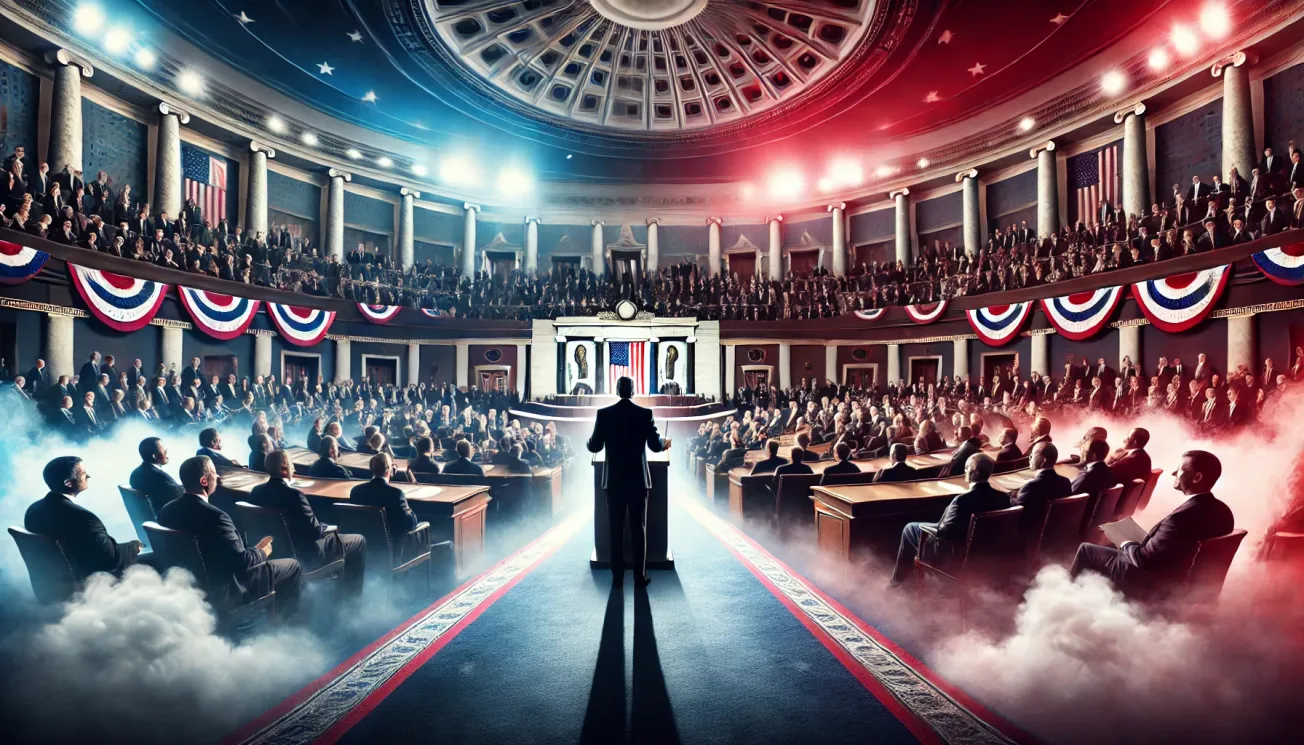Frame Control Theory: Who Dictates the Terms of Engagement?
President Trump’s speech is structured as a dominant assertion of authority, establishing himself as the primary actor shaping the American political landscape. The framing is binary, positioning himself and his administration as the force of action and progress while casting his opposition—mainly Democrats, bureaucrats, and foreign adversaries—as obstacles to be overcome.
- Repeated Use of Superlatives → "Greatest and most successful era in the history of our country" establishes dominance by asserting unprecedented achievements.
- Reframing Opposition as Obstructionists → "Democrats sitting before me...will not clap, will not stand, and certainly will not cheer for these astronomical achievements." This implies their irrelevance or unwillingness to support national progress.
- Claim of Unmatched Legitimacy → Election results are presented as an overwhelming "mandate" (winning all seven swing states), reinforcing absolute control.
- Disruptions in the Chamber → The removal of Rep. Al Green by the Sergeant at Arms is a moment of power reinforcement, showing control over institutional processes.
Dominance Hierarchy Assessment: Structural Power Holders
The speech consistently establishes Trump as the apex figure, while defining power dynamics between various actors:
- The Presidency as an Authoritarian Force
- "Over the past six weeks, I have signed nearly 100 executive orders and taken more than 400 executive actions."
- "I declared a national emergency on our southern border and deployed the U.S. military."
These statements reinforce unilateral executive action rather than coalition-building.
- Congress as a Reactive Body
- "Americans expect Congress to send me this funding without delay so I can sign it into law."
- This diminishes Congressional authority by making them an instrument of the President’s will rather than an independent legislative body.
- Federal Bureaucracy as an Adversary
- "My administration will reclaim power from this unaccountable bureaucracy."
- The speech frequently portrays government agencies (DOJ, FBI, social programs) as inefficient or corrupt, justifying purges and restructuring.
- Media as a Suppressive Force
- "Despite the best efforts of those who would try to censor us, silence us, break us, destroy us."
- This casts Trump’s administration as an insurgency against established elite institutions.
Leverage Analysis: Pressure Points and Control Mechanisms
The speech outlines multiple areas where leverage is actively being applied:
- Economic Leverage via Tariffs
- "Reciprocal tariffs kick in on April 2nd... Whatever they tariff us, we will tariff them."
- A direct economic weaponization strategy, particularly against China, South Korea, and the EU, exerting financial pressure for trade concessions.
- Social Leverage via Cultural Policy
- "I signed an order making English the official language of the United States."
- "We have removed the poison of critical race theory from our public schools."
- These moves consolidate support from nationalist and conservative factions, while forcing opposition groups into a defensive position.
- Corporate Leverage via Regulatory Power
- The creation of the Department of Government Efficiency (DOGE) led by Elon Musk suggests a corporate-government alliance that merges state and private power to cut bureaucracy and redefine economic incentives.
- Diplomatic Leverage via Geopolitical Realignments
- "I have already started reclaiming the Panama Canal."
- This implies a shift in U.S. foreign policy toward hard-power economic control over strategic global trade chokepoints.
Transactional vs. Moral Appeals: Value Exchange vs. Ethical Justifications
Trump’s rhetoric is overwhelmingly transactional, defining policy in terms of benefits to Americans as consumers, workers, and taxpayers rather than ideological morality.
- Transactional Example → “For $5 million, we will allow the most successful job-creating people from all over the world to buy a path to U.S. citizenship.”
- Immigration is framed as a monetized transaction, moving away from traditional ideological debates.
- Moral Appeal (Limited & Targeted)
- "We formally renamed that refuge in loving memory of your beautiful daughter, Jocelyn."
- Select moral narratives (victims of illegal immigration, murdered police officers) are weaponized to support hard policy actions (mass deportation, death penalty).
Asymmetry Detection: Control of Time, Resources, and Momentum
Trump positions his administration as operating at an accelerated pace, forcing opponents to react:
- Speed of Action
- "We have accomplished more in 43 days than most administrations accomplished in four years or eight years."
- Establishes an asymmetrical advantage in decision-making speed.
- Control of Resources
- “We found hundreds of billions of dollars of fraud and we have taken back the money.”
- Justifies reallocating wealth and government funds for alternative spending.
- Shifting the Narrative Focus
- Ukraine War: Trump introduces direct peace overtures, undermining existing policy frameworks.
- Greenland Acquisition: A preemptive narrative shift toward expansionist geopolitics.
Tactical Persuasion Techniques & Narrative Structuring
Trump’s speech uses repetition, comparative framing, and anecdotal storytelling to drive persuasion.
- Repetition → “It’s never been anything like it. It’s never been seen before.”
- Reinforces unprecedented success narratives.
- Comparative Framing → “Under Biden, the worst president in American history.”
- Constructs a binary contrast where all policy failures are externalized.
- Anecdotal Storytelling → “D.J., we’re going to do you the biggest honor of them all. You are now an agent of the U.S. Secret Service.”
- Uses emotional micro-narratives to make large policy shifts appear personal and relatable.
Conclusion: Power Consolidation & Strategic Trajectory
Trump’s address is a highly structured power consolidation speech, aimed at cementing dominance over the executive branch, legislature, corporate sector, and media discourse.
Strategic Outcomes:
✅ Economic Nationalism → Tariffs, trade wars, and domestic industry revival consolidate control over economic leverage points.
✅ Cultural Realignment → Elimination of DEI policies, gender policy shifts, and nationalism-centered education reforms.
✅ Bureaucratic Overhaul → Centralization of executive power, mass firing of opposition within the federal apparatus.
✅ Geopolitical Expansionism → Panama Canal reclamation, Greenland acquisition, energy expansion.
✅ Legal & Political Safeguards → Border enforcement, mass deportation, law enforcement empowerment.
Projected Resistance:
🔺 Corporate & Financial Sector Pushback → Companies reliant on global supply chains may resist trade policies.
🔺 Institutional Bureaucracy Resistance → Federal agencies will face purges, leading to internal opposition.
🔺 Democratic Opposition Mobilization → Policy reversals will lead to increased legislative gridlock.
🔺 International Diplomatic Fallout → European and Asian trading partners will retaliate against economic aggression.
Final Assessment: Trump is positioning himself as an authoritarian executor of a nationalist economic, cultural, and geopolitical realignment. The speech reinforces absolute control while escalating the dismantling of opposition structures within both government and society.






